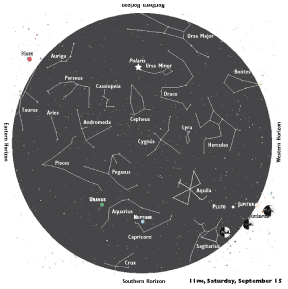Dark Nights and Bright Lights
The moon shines early but sets to reveal the Milky Way
A thin waxing crescent moon hugs the western horizon Thursday at sunset at 7:20. If you’re able to spot the moon in the 30 minutes before it, too, sets, you can likely make out the blue-white star Spica higher in the sky and maybe even Mercury, closer to the horizon. A pair off binoculars will increase your chances.
The sun sets at 7:18 Friday evening, revealing a more full crescent a little higher in the southwest. The moon shines above than Spica this evening, and it sets 25 minutes later than the night before.
Come Monday, the sun sets five minutes earlier, and the near-half-full moon is high in the southwest. Two bright red-orange lights shine above the moon. Antares is closest, not five degrees away, but Jupiter, about 10 degrees from the moon, easily outshines its stellar neighbor. All three objects draw closer together before setting around 10pm.
Tuesday’s first-quarter moon sets at 10:45. It is farther south than Jupiter and Atares, but the three still form a loose triangle.
Away from city lights, the setting moon in these late-summer nights reveals the river of stars flowing overhead. The Milky Way divides our night sky into two fairly equal sections of sky, stretching from Cassiopeia in the north and Crux in the south.
In Asia, people believed that the hazy band of stars was the Silvery River of Heaven. In India, they call the Milky Way Akashaganga, meaning Ganges River of the Sky. In Norse mythology, the Milky Way was called Linnunrata, which means pathway of the birds. In today’s world, scientists have discovered that migratory birds do in fact use the Milky Way as a celestial guide on their long travels.
Tidelog®
Illustration: © Copyright 1925 M.C. Escher/Cordon Art-Baarn-Holland; Graphics: © Copyright 2007 Pacific Publishers. Reprinted by permission from the Tidelog graphic almanac. Bound copies of the annual Tidelog for Chesapeake Bay are $14.95 ppd. from Pacific Publishers, Box 480, Bolinas, CA 94924. Phone 415-868-2909. Weather affects tides. This information is believed to be reliable but no guarantee of accuracy is made by Bay Weekly or Pacific Publishers. The actual layout of Tidelog differs from that used in Bay Weekly. Tidelog graphics are repositioned to reflect Bay Weekly’s distribution cycle.Tides are based on National Oceanic and Atmospheric Administration and are positioned to coincide with high and low tides of Tidelog.
